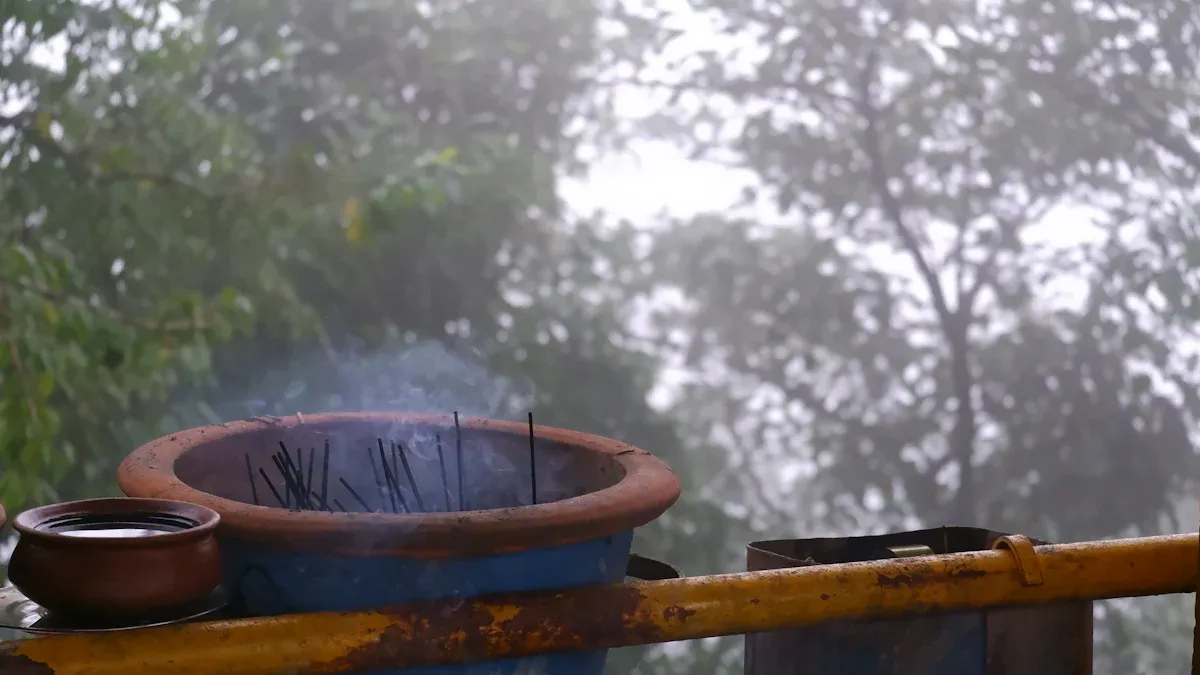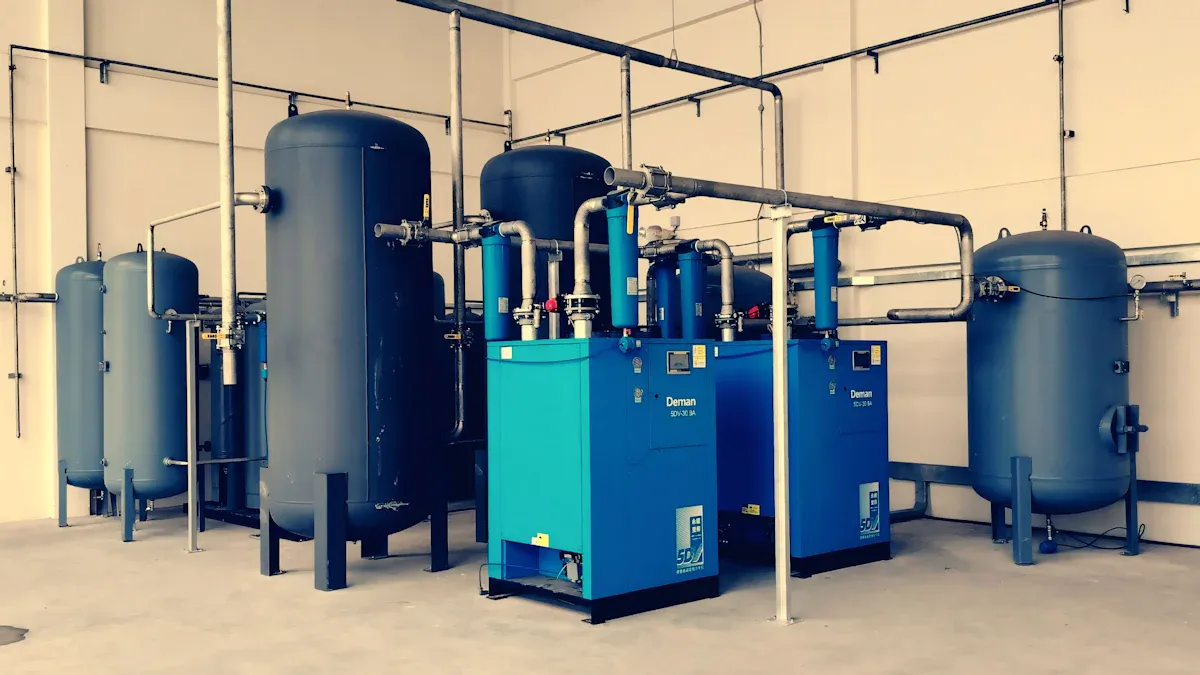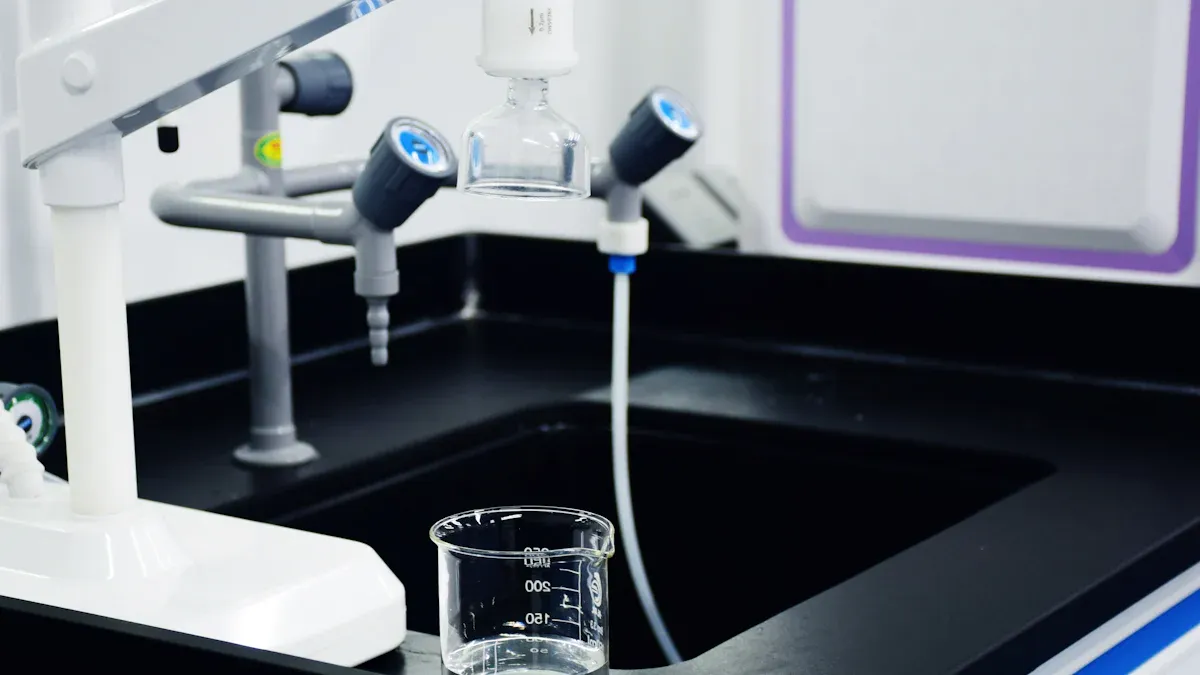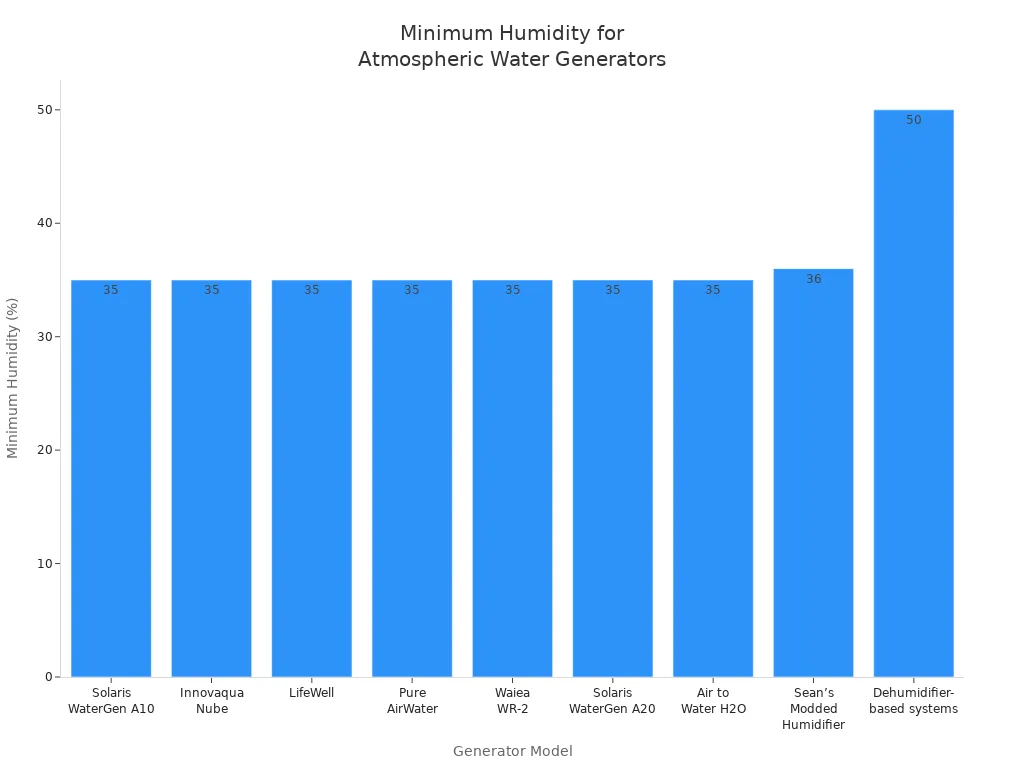
You can use a water making machine to pull clean drinking water straight from the air. These machines use different methods, such as cooling air to make water droplets (condensation), using special materials that grab moisture (desiccants), filtering with membranes, or trapping fog on nets. Each method works best in certain climates. Scientists believe that these technologies could help provide safe water for about one billion people, especially where clean water is hard to find.
Water making machines provide fresh water at home, in emergencies, and in places with limited water, but they need regular maintenance and enough humidity to work well.

When you use a water making machine, the first step is to pull air from the environment. The machine uses fans to draw in large amounts of air. Some high-capacity machines can process about 648 cubic meters of air every hour. This is almost as much air as you would find in a large classroom.
|
System Description |
Water Production Rate |
Airflow Rate |
Approximate Air Volume Processed per Hour |
|---|---|---|---|
|
Novel atmospheric water generator system |
250 kg/h freshwater |
3 kg/s airflow |
~648 m³/h |
|
Two-ton air conditioner (for reference) |
2.07 L/h water |
Not specified |
N/A |
Before the air enters the machine, it passes through several filters. These filters remove dust, dirt, and tiny particles. Some filters can even catch particles smaller than 2.5 microns. Other systems use ozone filters to kill germs and special water filters to remove color, odor, and dissolved salts. This keeps the water clean and safe for you to drink.
Multi-layer air filters remove dust and dirt.Tip: Clean air means cleaner water. The better the filters, the safer your drinking water.
The most common way a drinking water from air machine works is by condensation. The machine cools the air until water vapor turns into liquid water, just like how dew forms on grass in the morning. The machine uses special cooling systems to make this happen faster and more reliably than nature.
|
Aspect |
Radiative Condensers (Natural Dew Formation) |
Active Condensers (Water Making Machines) |
|---|---|---|
|
Mechanism |
Passive cooling below dew point |
Active cooling or desiccant materials |
|
Dependency on Environment |
Needs high humidity, low wind, clear skies |
Works in many weather conditions |
|
Water Yield |
Up to 0.6 L/day/m² |
15–50 L/day (small units), up to 200,000 L/day (large scale) |
|
Efficiency Scaling |
Drops above 1 m² |
High yields at large scale |
|
Energy Requirement |
None |
Needs electricity or other energy |
|
Cost |
Low |
Higher due to energy use |
|
Reliability |
Weather-dependent |
Reliable, controlled conditions |
A water making machine can produce much more water than natural dew collectors. Small machines can make 15 to 50 liters per day, while large ones can make up to 200,000 liters. However, these machines need energy to run. Some household machines use between 0.5 and 1.0 kilowatt-hours of electricity for each liter of water. More efficient systems can use as little as 0.22 kilowatt-hours per liter.
Some air to water generator use desiccants or membranes to pull water from the air. Desiccants are special materials that soak up moisture, like a sponge. The machine then heats the desiccant to release the water, which is collected and purified.
Membrane-based systems use thin layers that let water vapor pass through but block other things. Some membranes, like polyamide 6-LiCl nanofibrous membranes, can produce a lot of water—up to 230 liters per kilogram of membrane each day. Membrane-based systems are actually a type of desiccant system, so their water yield is similar. Scientists are still studying which method works best in different places.
Note: Desiccant and membrane systems can work even when the air is not very humid, making them useful in dry areas.
In some places, you can collect water from fog. Machines use fine nets or mesh to trap tiny water droplets from the air. This method works best in coastal or mountain areas where fog is common.
Another new technology uses materials called metal-organic frameworks (MOFs). MOFs can grab water molecules from the air, even when it is very dry. However, making MOFs on a large scale is hard. You need to solve problems like keeping the MOFs stable, making them cheaply, and making sure they last a long time. Engineers also need to design good ways to move air and heat through the machine. Using MOFs safely and efficiently is still a challenge, but they could help in the future.
MOFs must keep high water capacity at large scale.A water making machine can use one or more of these methods to give you clean water. The choice depends on where you live and how much water you need.

When you use a water making machine, you get water that starts as vapor in the air. To make sure this water is safe, the machine uses several filtration steps. First, air passes through a non-woven filter that catches dust, exhaust gases, and odors. After condensation, the water moves through a carbon mesh filter. This filter removes chemicals and improves taste. Many machines use multi-stage filtration, including reverse osmosis and UV treatment, to remove bacteria and other impurities.
Here is a typical sequence of filtration steps:
Air intake and initial filtration
Condensation of water vapor
Carbon mesh filtration
Reverse osmosis purification
UV sterilization
Mineralization and final filtration
If water stays in the reservoir for more than a day, the machine filters it again to keep it fresh. These steps help the water meet international safety standards.
Tip: Multi-stage filtration gives you cleaner and safer drinking water.
Sterilization is important for removing germs and bacteria from your water. Most water making machines use ultraviolet (UV) light or ozone treatment. UV sterilization works by shining UV light on the water, which destroys the DNA and RNA of microorganisms. This method does not change the taste or smell of the water. UV systems work well in cold water and do not leave any residue.
Ozone treatment uses a powerful oxidizer to kill bacteria, viruses, and fungi. Ozone can improve water quality, but it may create odors and can be corrosive to equipment. In cold water, UV sterilization is usually more effective than ozone. You get immediate, chemical-free disinfection with UV, making it a safer choice for most users.
|
Sterilization Method |
How It Works |
Pros |
Cons |
|---|---|---|---|
|
UV Light |
Destroys DNA/RNA of germs |
No residue, fast, safe |
Needs electricity |
|
Ozone |
Oxidizes contaminants |
Powerful, broad-spectrum |
Can cause odors, corrosive |
After filtration and sterilization, the water may taste flat because it lacks minerals. Mineralization adds essential minerals like calcium, magnesium, and potassium. These minerals improve taste and provide health benefits. The process also helps balance the pH, often making the water slightly alkaline (pH 7.6 to 8.1). Mineralization acts as a final filtration step, removing any leftover particles and making your water fresh and healthy.
Minerals added: calcium, magnesium, potassiumYou get water that is not only pure but also refreshing and good for your body.
You will notice that the amount of water your machine produces depends on the air’s humidity and temperature. When the air is warm and humid, your water making machine works best. Most machines need at least 35% humidity to operate efficiently. If the temperature drops below 65°F (18°C) or the humidity falls under 30%, the machine’s water output drops sharply. Some advanced systems can boost humidity inside the machine to help in dry conditions, but most work best in warm, moist air.
|
Atmospheric Water Generator |
Minimum Humidity |
|---|---|
|
Solaris WaterGen A10 |
35% |
|
Innovaqua Nube |
35% |
|
LifeWell |
35% |
|
Pure AirWater |
35% |
|
Waiea WR-2 |
35% |
|
Solaris WaterGen A20 |
35% |
|
Air to Water H2O |
35% |
|
Sean’s Modded Humidifier (DIY) |
36% |
|
Dehumidifier-based systems |
50% |

Tip: For the best results, use your water making machine in places with warm temperatures and high humidity.
Most water making machines use electricity to cool air and collect water. You might connect your machine to the power grid, but many new models use solar panels. Solar-powered machines let you make water even in remote places without electricity. Using solar energy lowers your costs and helps the environment. Some machines use smart technology to track energy use and improve efficiency. High-efficiency models can use as little as 0.35 to 0.45 kilowatt-hours for each liter of water. Solar power makes these machines more affordable and sustainable, especially where electricity is expensive or unreliable.
When you use a water making machine, you help reduce the need for bottled water and long-distance water transport. Solar-powered machines do not release greenhouse gases, so they are better for the planet. You can use these machines off-grid, which helps people in remote or dry areas. New designs use less energy and work with renewable sources, making them even more eco-friendly. As technology improves, these machines will become a greener way to get clean water, helping both people and the environment.
You can use a water making machine in many places. At home, you might set up a compact unit for your family’s daily drinking needs. These machines work well in apartments, rental homes, and even high-rise buildings where water pressure is low. You do not need special plumbing—just plug it in and start making water. Many people use these machines to cut down on plastic waste and avoid bottled water. Some models connect to your home plumbing or HVAC system, so you get fresh water from your tap. Businesses like hotels, restaurants, and factories also use these machines to provide safe water for guests and workers. In emergencies, you can rely on a water making machine for clean water when other sources fail.
Tip: You can choose from different sizes and models, from small countertop units to large machines for offices or factories.
A water making machine can help solve water shortages, especially in dry or remote areas. In places like rural Kenya, people use these machines to get safe drinking water where wells or rivers are not reliable. Some machines use special materials to pull water from very dry air, even when humidity drops below 20%. The table below shows how different types work in dry places:
|
Type of AWG |
Works in Low Humidity? |
Energy Use |
Best For |
|---|---|---|---|
|
Adsorption-based (MOFs) |
Yes |
Moderate |
Arid, semi-arid regions |
|
Condensation-based |
No |
High |
Humid, coastal areas |
You get the best results in warm, humid climates, but new technology is making these machines more useful in deserts and drought zones.
You may face some challenges with a water making machine. High purchase and installation costs can make it hard for some people to afford. You need to replace filters and check the system often to keep the water safe. In dry weather, the machine uses more electricity and makes less water, which can raise your energy bills. Large machines take up space and need special care. Older models may need more manual work and cost more to run. Even with these issues, many people find these machines valuable for a steady water supply, especially when other sources are not safe or reliable.
Note: Using solar power and new designs can lower costs and make these machines more eco-friendly over time.
A water making machine gives you clean water by pulling moisture from the air. You get benefits like fresh water in remote places, less plastic waste, and help during emergencies. However, you need to think about local humidity, temperature, and energy use. Check the table below for a quick look at the main benefits and limits:
|
Benefit |
Limitation |
|---|---|
|
Fresh water anywhere |
Needs high humidity and energy |
|
Reduces plastic waste |
Lower output in dry or cold climates |
|
Good for emergencies |
Requires regular maintenance |
Consider your climate and daily needs before choosing a water making machine.
 online service
online service sale@accairwater.com
sale@accairwater.com +86 18559227773
+86 18559227773